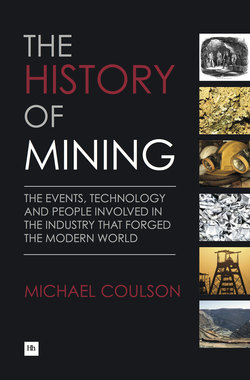Читать книгу The History of Mining - Michael Coulson - Страница 16
На сайте Литреса книга снята с продажи.
Jordan
ОглавлениеThe advanced state of Egyptian and Mesopotamian society and the sophisticated nature of their buildings and the mines and quarries that provided the raw materials suggests that the Mediterranean/Middle East region, until the rise of the Roman Republic and Empire, was the centre of the civilised world, in contrast to today. We should therefore not be surprised that other parts of the region, and in particular Jordan, have a very long history of mining, going back to the 5th millennium BC.
The copper mines of Feinan, 40 miles south of the Dead Sea, underline the importance of Jordan as a mining region at that time. Amongst the ancient mining sites uncovered are Wadi al Abiad, Wadi Ratiye and Qalb Ratiye. Evidence of more than 100 mines has been found in this broad area, where ancient miners cut up to 30 feet drives into hillsides following the visible copper veins. The adits and drives that have been uncovered by archaeologists appear to have been kept low and were no more than 8 feet wide, with pillars to support the roof. This enabled miners to gain access to the veins, mining them in a gallery setting, maximising the amount of metal taken out and minimising the amount of digging required.
This room and pillar method of mining was accompanied by backfilling in a number of cases, which is an unusually advanced concept for the time and required considerable physical effort on the part of the miners. This was effort without any obvious economic return, except to avoid the galleries’ roofs collapsing – perhaps an early example of mine reclamation. Flint picks and stone hammers found around the site, very much as elsewhere, provided the tools needed for mining in these early days.
As well as gallery mining there were a number of small-scale copper diggings at Madsus, another regional mining site. Here copper ore had been washed down over time from higher levels to terraces below, where the miners dug small pits to retrieve the copper-enriched material. These diggings were close to the ancient settlement of Wadi Fidan 4 where evidence has been found of residues from copper smelting, suggesting an integrated settlement that mined, treated and made copper objects such as weapons.
The investigation of Wadi Fidan suggests that the smelting process was the familiar one whereby a crucible containing copper ore was covered by charcoal and fired to start the smelting of the high grade ore. The slag that has been found at Wadi Fidan suggests that copper metal in this ancient process did not, as would become the case in later eras, become fully molten.
It is also worth noting that at Feinan the mines were not in close proximity to the smelting settlements and ore would have been transported some miles to be treated. This probably occurred in order to get economies of scale at the smelting end; in due course mine output would have expanded and it would then have been worthwhile having smelting capability close to the actual mines.
These mines were clearly operational for centuries and were worked again by the Romans when they applied their advanced mining technology in the 1st century BC.
